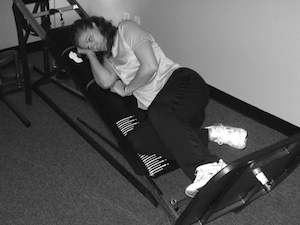- You are here:
- Home »
- Blog »
- Joint Health / Pain »
- The Knee Rehab Myth That Ruined a Good Lunch
The Knee Rehab Myth That Ruined a Good Lunch
Several years ago, a new surgeon had joined the practice of an orthopedist whom I had known all of my career. He wanted me to meet his new partner. So, we had lunch.
Our discussion turned technical when my longtime orthopedic friend asked me to explain my position on VMO (Vastus Medialis Oblique) strengthening for patellofemoral pain- one of the four muscles of the quadriceps muscle group – to his new partner. He said, “I think you’ll find Doug’s ideas very enlightening. He’s helped me and my patients for years.” So, I shared my perspective. Who knew such an innocent subject as a muscle could cause such a riff.
The new surgeon said, “Well, everyone knows that you do isolated VMO strengthening for patellofemoral pain. I can’t believe you don’t do this!”
To which I replied in my best Spockian way, “Well, you can’t. It doesn’t have a separate nerve supply. You can’t isolate it. You have to train all of the muscles and if you’re going to do that, you might as well be weight bearing.”
I’m not sure there’s a color of red that could describe the hue on his face right then.
He said, “Nice meeting you,” with the emotion of a piece of steel and got up and walked out. No handshake either.
I looked at my orthopedist friend and said, “I guess he won’t be sending any people our way.”
“Well, he’ll figure it out. You’re right. Don’t worry about it,” he replied.
I don’t think he ever figured it out.
Back in 2005, I wrote about the problem of focusing on the VMO for patellofemoral pain, as you find in Runner’s Knee Syndrome, and it caused quite a ruckus. People with knee pain, especially patellofemoral pain, are often told by clinicians to strengthen their VMO to improve the alignment and tracking of the patella. By improving where the patella sits and travels, knee pain will improve – so the theory goes. The exercises for this selective strengthening are typically quad sets, limited range of motion knee extensions with or without the addition of electrical stimulation. But, since the VMO doesn’t have its own nerve supply, you can’t isolate the muscle from the rest of the quadriceps.
But, this isn’t just my opinion. Cerny examined this in 1995 and found no difference between the VMO activity and the rest of the quadriceps for a variety of common exercises used to target the VMO.
And now, another study reports:
“A large number of PFPS patients can experience significant improvements in pain, function and Quality of Life, at least in the short term, with quadriceps femoris rehabilitation, with or without emphasis on selective activation of the VMO component.”
So, why do clinicians still use exercises that attempt to isolate a muscle which cannot be isolated?
In most cases, it’s because the alternatives – exercising with full body weight during a squat for example, are too hard and it hurts. Therefore, you have to get off your feet and either sit down or lie down to work on your leg strength which means things like quad sets, short arc knee extensions, leg lifts.
But, you can only get so far with that approach before the stimulus is insufficient to boost the leg strength.
For those of you with knee pain, this means that working on your entire leg strength is preferred to attempting to isolate the VMO. Why? Because the knee serves at the pleasure of the hip and ankle. It’s stuck in between and needs to learn to work in harmony.
People with knee pain will almost always have weakness of the hip on the same side as the knee pain which means that the hip will have trouble directing and controlling motion at the knee. So, to get everyone to play together, the hip, knee, and ankle, you have to train on your feet (even if you have to reduce the effect of gravity)
As an example, in the image to the right, we are using less than full body weight (the angle of  the device reduces the effective load) yet we can achieve muscle fatigue without join pain. As the leg strength increases, you increase the angle of the device.
the device reduces the effective load) yet we can achieve muscle fatigue without join pain. As the leg strength increases, you increase the angle of the device.
This saves time, teaches your leg how to move relative to the hip and ankle and is, in most cases, pain free.
Cheers,
DK
PS – get all the details you need to overcome patellofemoral knee pain – including video of tests and selected drills, in my book, The Runner’s Knee Bible. Click here for more information.
